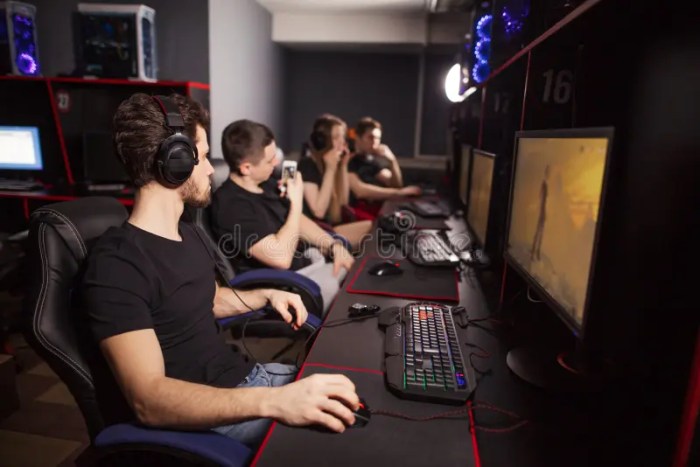Casual Gamers: They’re everywhere, from the subway to your living room, engaging in quick bursts of gameplay or longer, more immersive sessions. This isn’t your hardcore, all-night raiding crew; casual gamers represent a massive and diverse group, united by a love of games but driven by different motivations and preferences. We’ll explore their habits, the games they love, and what makes this segment of the gaming world so unique and influential.
This exploration will cover everything from defining who exactly counts as a “casual gamer” – considering factors like playtime, game choice, and overall gaming goals – to examining the booming mobile gaming market and its impact on casual players. We’ll delve into the psychology behind their choices, the social aspects of their gaming experiences, and even speculate on the future of this ever-evolving segment of the gaming industry.
Defining Casual Gamers

So, you’re wondering what exactly makes a casual gamer a
- casual* gamer? It’s not just about playing games – it’s about
- how* and
- why* they play. Unlike their hardcore counterparts, casual gamers approach gaming with a different mindset, prioritizing fun and relaxation over intense competition and mastery.
Casual gamers are defined primarily by their playtime, the types of games they enjoy, and their overall motivations for playing. They typically dedicate less time to gaming than hardcore gamers, often fitting in sessions around other commitments. Their game choices frequently lean towards simpler mechanics, shorter play sessions, and less demanding skill requirements. The core motivation for casual gaming is usually entertainment and stress relief, rather than achieving high rankings or mastering complex strategies.
Playtime and Game Genres
Casual gamers generally play for shorter bursts of time, often fitting gaming into their daily routines rather than making it a central focus. Think a quick round of Candy Crush during a lunch break or a half-hour session of Animal Crossing before bed. Hardcore gamers, on the other hand, might dedicate hours each day to perfecting their skills in complex games like World of Warcraft or League of Legends.
Genre preference also plays a role; casual gamers often gravitate towards mobile games, puzzle games, or simpler RPGs, while hardcore gamers might prefer complex strategy games, MMORPGs, or competitive shooters. A casual gamer might enjoy a quick match of “Among Us” with friends, while a hardcore gamer might be grinding for rare loot in a raid.
Casual Gamers Across Age Demographics
The definition of “casual gamer” isn’t fixed across age groups. For instance, a 60-year-old might consider a daily game of Solitaire on their tablet “casual,” while a teenager might define it as playing a few rounds of Fortnite with friends. Younger casual gamers might prioritize social aspects of gaming, such as playing multiplayer games with friends or engaging with online communities.
Older casual gamers, on the other hand, might focus more on puzzle games or single-player experiences that offer relaxation and mental stimulation. The games themselves often reflect these differences; younger casual gamers might be drawn to trendy mobile games or battle royales, whereas older casual gamers might prefer classic puzzle games or word games.
Gaming Setup and Preferred Platforms
The typical casual gamer’s gaming setup is significantly less elaborate than a hardcore gamer’s. While a hardcore gamer might invest in a high-end PC with multiple monitors and peripherals, a casual gamer might be perfectly content with a smartphone, a tablet, or a Nintendo Switch. Accessibility and ease of use are key factors. The preferred platforms reflect this: mobile phones, tablets, and casual gaming consoles like the Nintendo Switch are incredibly popular among casual gamers due to their portability and ease of use.
In contrast, a hardcore gamer might invest heavily in a powerful PC, a high-refresh-rate monitor, and a high-end gaming mouse and keyboard.
Motivations and Engagement

Casual gamers, unlike their hardcore counterparts, approach video games with a different set of expectations and motivations. Their engagement is often driven by shorter play sessions and a desire for readily accessible fun, rather than complex narratives or high-skill mastery. Understanding these nuances is key to designing successful games and maintaining player retention.Casual gamers are primarily motivated by a range of factors that often intertwine.
Stress relief is a major driver, with many turning to games as a quick and easy escape from daily pressures. The simple act of engaging with a game, even a simple puzzle or match-three title, can provide a mental break and a sense of accomplishment. Social interaction is another significant motivator; many casual games are designed around multiplayer elements, fostering competition and collaboration among players.
Finally, pure entertainment is a core reason for play; the ease of access and the variety of casual games provide a readily available source of amusement and distraction. Games like Candy Crush Saga, for example, exemplify this with their simple mechanics and addictive gameplay loops.
Methods for Engaging Casual Gamers and Increasing Retention
Game developers can employ several strategies to effectively engage casual gamers and improve retention rates. A key element is to prioritize ease of access and intuitive gameplay. Complicated controls or lengthy tutorials can quickly deter casual players. Games should be easily picked up and played in short bursts, allowing players to fit gaming into their busy schedules.
Regular updates with fresh content, such as new levels, challenges, or cosmetic items, are crucial for maintaining player interest. Implementing social features, like leaderboards and in-game chat, encourages competition and interaction, further enhancing engagement. Furthermore, incorporating rewarding progression systems, even if the rewards are minor, can provide a sense of accomplishment and motivate players to continue playing.
Consider the success of mobile games like Pokémon Go, which utilized location-based gameplay and social interaction to maintain high engagement levels.
Effective Monetization Strategies for Casual Games
Casual gamers generally have different spending habits compared to hardcore gamers. They are less likely to spend large sums of money on a single game but may be more willing to make small, frequent purchases. Understanding this nuance is crucial for implementing successful monetization strategies.
| Monetization Strategy | Pros | Cons | Example |
|---|---|---|---|
In-App Purchases (IAPs)
|
Easy to implement, non-intrusive, allows players to personalize their experience. | Can feel exploitative if not carefully balanced, may not generate significant revenue if not well-designed. | Many mobile games offer various skins or outfits for characters. |
| Freemium Model with Ads | Low barrier to entry, broad reach, can generate revenue from a large player base. | Can be disruptive to gameplay, may alienate players who dislike ads, requires careful ad placement. | Many free-to-play mobile games use this model. |
| Subscription Model with Premium Features | Provides consistent revenue stream, incentivizes player loyalty. | Requires a compelling value proposition to justify the subscription cost, may not appeal to all casual gamers. | Some puzzle games offer monthly subscriptions for unlimited hints or extra lives. |
| Timed Events and Limited-Time Offers | Creates a sense of urgency, encourages players to return regularly. | Can feel manipulative if overused, may lead to player burnout. | Many mobile games use holiday-themed events or limited-time bundles. |
The Impact of Mobile Gaming: Casual Gamers

The rise of casual gaming is inextricably linked to the explosive growth of mobile gaming. The sheer accessibility and convenience offered by smartphones and tablets have democratized gaming, bringing it to a vastly wider audience than ever before.
No longer confined to dedicated gaming consoles or PCs, casual games are now readily available at any time, anywhere, transforming the landscape of the gaming industry.Mobile gaming’s influence on the casual gaming market is undeniable. The ease of access, coupled with the always-on nature of smartphones, has made casual games a perfect fit for short bursts of playtime, perfectly suited to the busy lifestyles of many casual gamers.
This has led to a massive surge in the number of casual gamers, many of whom may not have considered themselves “gamers” prior to the mobile revolution.
Mobile Gaming Accessibility and Convenience
The low barrier to entry is a key factor. Most mobile games are free-to-play, requiring only a smartphone download. This contrasts sharply with the higher initial investment required for consoles or PCs, including the purchase of the hardware itself, plus potentially additional costs for games. Further, mobile games typically require minimal technical knowledge or setup. The intuitive touch controls and immediate gameplay eliminate the learning curve often associated with more complex console or PC games.
This ease of access broadens the potential player base exponentially. The portability of mobile devices also contributes significantly to convenience. A quick game can be played during commutes, lunch breaks, or even while waiting in line. This “snackable” gaming experience perfectly aligns with the casual gamer’s preference for short, easily digestible gameplay sessions.
Mobile vs. Console/PC Gaming Experiences
While both mobile and console/PC gaming offer casual experiences, there are significant differences. Mobile games are often designed with shorter play sessions in mind, incorporating simple mechanics and intuitive controls. Games are frequently free-to-play, often monetized through in-app purchases or advertisements. Console and PC games, on the other hand, tend to offer more complex gameplay, richer graphics, and longer play sessions.
These often involve a higher level of commitment and investment, both in terms of time and money. The social aspects also differ; mobile games might emphasize quick, asynchronous interactions, while console/PC games might prioritize synchronous multiplayer experiences.
Growth of Mobile Gaming Among Casual Gamers (Visual Representation)
Imagine a bar graph. The horizontal axis represents the years, from 2019 to 2023. The vertical axis represents the percentage of casual gamers who primarily play on mobile devices. The bars would show a clear upward trend. The bar for 2019 might be at, say, 60%, rising to approximately 75% by 2023.
This visual representation would clearly illustrate the substantial growth of mobile gaming within the casual gaming community over the past five years. The increase reflects the growing popularity of mobile devices and the increasing accessibility and convenience of mobile games, drawing more people into the casual gaming market. For instance, the global success of games like Candy Crush Saga and Pokémon GO vividly demonstrates this trend.
These games, accessible on mobile devices, reached massive audiences, solidifying mobile gaming’s dominance in the casual gaming sector.
The Future of Casual Gaming

The casual gaming landscape is in constant flux, driven by technological advancements and shifting player preferences. Predicting the future is always tricky, but by analyzing current trends and emerging technologies, we can paint a reasonably accurate picture of what casual gaming might look like in the years to come. The convergence of mobile technology, cloud gaming, and increasingly sophisticated AI will fundamentally reshape how casual gamers interact with their favorite games.The next five years will witness a significant evolution in casual gaming, marked by several key developments.
These developments will impact game design, accessibility, and the overall experience for players. We can expect to see a continued rise in hyper-casual games, but with a greater focus on innovative gameplay mechanics and richer social features.
Emerging Technologies and Their Impact
The integration of augmented reality (AR) and virtual reality (VR) technologies will play a significant role in shaping the future of casual gaming. AR games, overlaying digital elements onto the real world, are already popular, with titles like Pokémon Go demonstrating their mass appeal. We can anticipate more sophisticated AR games that blend seamlessly with our everyday lives, encouraging more casual play and social interaction.
VR, while currently more niche, has the potential to deliver truly immersive casual experiences, particularly in puzzle or narrative-driven games. Imagine solving a jigsaw puzzle in a virtual museum or exploring a whimsical fantasy world from the comfort of your living room. These immersive experiences could broaden the appeal of casual gaming to a wider audience. The growth of cloud gaming services also offers a significant opportunity for casual gamers, providing access to high-quality games without the need for expensive hardware.
This democratizes access and opens up the market to players who previously may have been limited by device capabilities or cost.
Evolving Player Preferences and Game Design
Casual gamers are increasingly seeking shorter, more accessible gaming sessions that fit into their busy lifestyles. This trend will likely lead to a rise in games with shorter levels, simpler controls, and easily digestible narratives. The demand for quick, satisfying gameplay loops will continue to drive the popularity of hyper-casual titles. However, we will also see a growth in games that offer more depth and replayability, even within a casual context.
This could involve games with evolving meta-games, rewarding long-term engagement with unique content or customizable characters. The focus will be on offering players a variety of options, catering to diverse preferences for both immediate gratification and longer-term investment.
Challenges Facing the Casual Gaming Market, Casual Gamers
Maintaining player engagement in a saturated market will be a significant challenge. The sheer volume of casual games available means developers must constantly innovate to stand out. Another key challenge is monetization. Finding a sustainable revenue model that doesn’t alienate casual players with aggressive in-app purchases will be crucial for many developers. Balancing free-to-play models with fair and enjoyable gameplay remains a significant hurdle.
Finally, the issue of data privacy and security will continue to be a concern, especially with the increasing integration of personal data in mobile gaming experiences. Developers must prioritize transparency and responsible data handling to maintain player trust.
Predictions for Popular Casual Game Types (Next 5 Years)
The next five years will likely see a surge in popularity for games that seamlessly integrate with social media platforms and encourage player interaction. Games with asynchronous multiplayer elements, where players can engage at their own pace, will likely thrive. We might see more casual games that incorporate elements of gamification, applying game mechanics to everyday tasks or challenges.
Think of fitness apps that use game-like rewards to motivate users or educational apps that use game design principles to enhance learning. Games that emphasize social interaction and collaboration, offering players a sense of community, will also likely find success. For example, cooperative puzzle games or casual strategy titles where players can team up to achieve common goals.
Finally, the rise of personalized experiences will see games adapting to individual player preferences, offering unique challenges and rewards tailored to their play style. This level of customization could enhance engagement and retention significantly. Consider Candy Crush Saga’s ever-evolving levels and challenges, a model that will likely be replicated and refined in the future.
Quick FAQs
What’s the difference between a casual and a hardcore gamer?
Hardcore gamers often dedicate significant time and resources to gaming, focusing on competitive play and mastery. Casual gamers play for shorter periods, prioritize enjoyment and relaxation, and may play a wider variety of games.
Are casual gamers primarily younger people?
No, casual gamers span all age groups. While younger generations may have grown up with readily available mobile games, older gamers also enjoy casual titles for relaxation and social interaction.
Do casual gamers spend money on games?
Yes, but their spending habits often differ from hardcore gamers. They may make smaller, more frequent purchases, often driven by in-app purchases or cosmetic items.
What are some examples of successful casual games?
Candy Crush, Angry Birds, and Pokémon Go are prime examples of incredibly successful casual games that have captivated millions of players worldwide.
